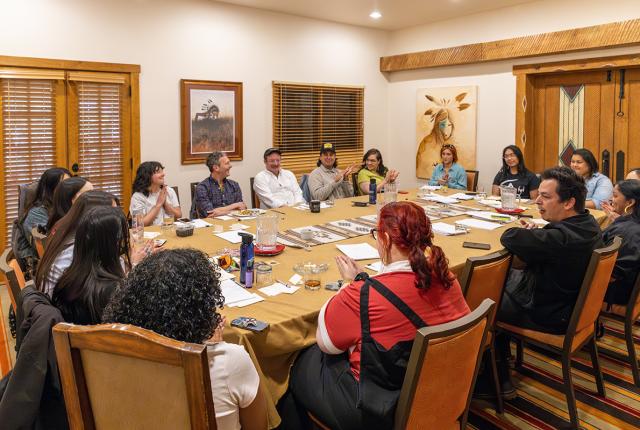“I ALWAYS LIKE to say that clay is really my family’s way of storytelling,” says Charine Pilar Gonzales. The Santa Fe–based filmmaker and screenwriter, who comes from six generations of San Ildefonso potters, was one of four spring 2024 participants in the Sundance Institute Indigenous Program’s annual Native Lab. “It made it an easy transition into the world of film and television for me. Pueblo people have been telling stories since time immemorial, so this is just a continuation of that long legacy.”
Founded in 2004, the program has brought Native and Indigenous storytellers to Santa Fe for one-on-one mentoring, workshops, and roundtable discussions to help develop their techniques and work. Initially, Native Lab focused on short films but shifted in 2020 to fictional feature- and pilot-length screenplays. This year’s lab, which was held at Hotel Santa Fe, included Pilar Gonzales, Don Josephus, Ryland Walker Knight, and Lindsay McIntyre.
Pilar Gonzales worked to develop her screenplay for NDN Time, a pilot for an hour-long TV fantasy drama, which follows a Tewa college student who learns to master her dimension-bending abilities to expose the nuclear secrets that threaten her pueblo. It takes its name from the phrase “Indian time,” which is often used pejoratively to stereotype Native people as always running late. If the series gets off the ground, she hopes to help redefine its meaning.
“I believe a more Tewa perspective of Indian time is about being in our own timeline, which is connected to the greater circle of time,” Pilar Gonzales says. “Ultimately my project is about my protagonist’s growth through grief. She finds ways to be present and grateful in the moment.”
Advisors Patrick Brice, Tai Leclaire, Kishori Rajan, and Jon Raymond are all working professionals in the industry. Leclaire is an actor, writer, and director who worked as a writer and editor during two seasons of NBC’s Rutherford Falls (2021–2022). His film, Headdress, premiered at the Sundance Film Festival last year. “I was a fellow in 2022,” he says. “It’s an incredible program. They’re not afraid to let us just be us.”
As director of the Sundance Indigenous Program, Adam Piron appreciates the connection and creativity on both sides of the mentorship program. “It’s predominantly designed around getting people to crack open their screenplay, figure out what’s working, what’s not working, and how they can innovate and push their creative practice,” he says.
It’s part of a legacy that started with the film festival’s founding in 1978 and its mission to amplify Native voices. “We like to say we’ve been supporting four generations of Indigenous filmmakers,” Piron adds. “We’re working on identifying the fifth generation while sustaining the fourth as much as we can.”
Read more: Her wizardry brings zombies, monsters, and superheroes to life.



